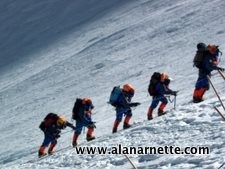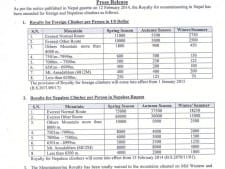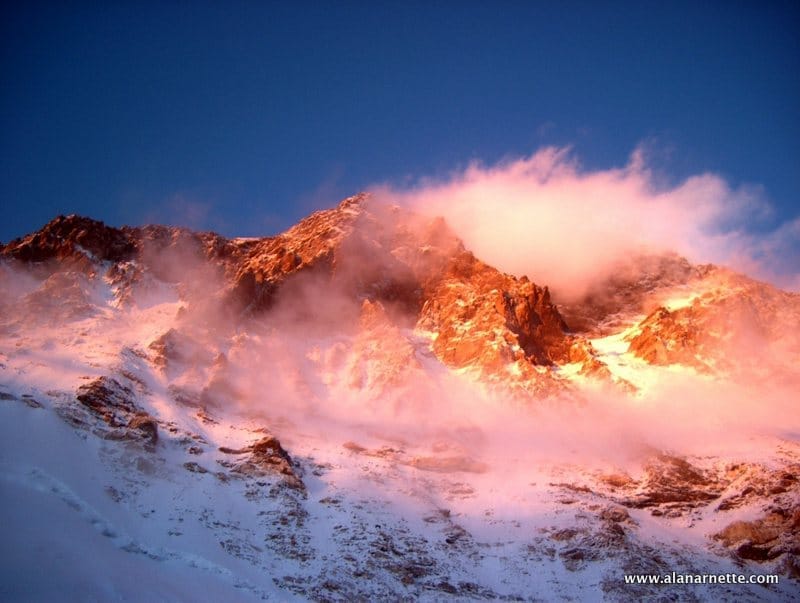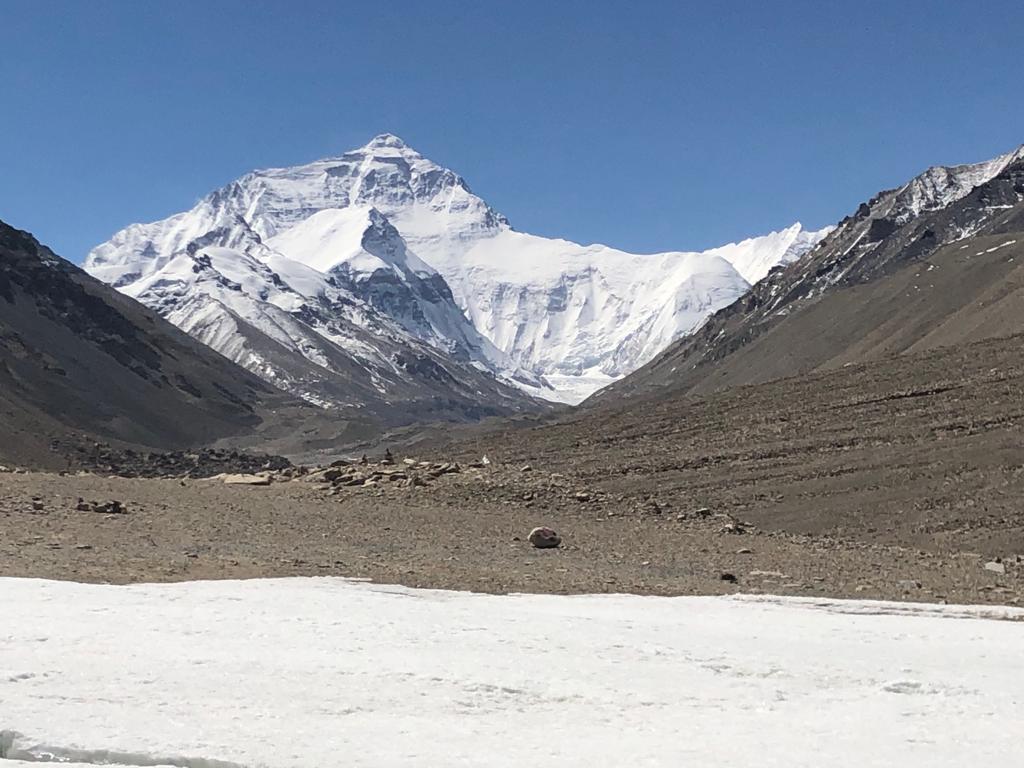Its been rumored for the past two years that Nepal will increase the permit fee to climb Everest from the current $11,000 to $15,000 but now, according to conversations I had this week with both major foreign and Nepali operators, there is talk of increasing the Everest permit fees to as much as $25,000 per person. To my knowledge, no final decision has been made.
Ministry Under Pressure
With global pressure for Nepal to “fix” Everest after the 11 deaths just this past spring, the Government appears to be struggling with various options while protecting their cash cow. There are no lack of opinions on how to fix Everest but they range from closing the mountain altogether (which will never happen) to instituting tighter requirements for both climbers and guides to increasing permit fees to address the inexperienced, low-cost climbers. The central issue appears to be money – both for the government and the guides.
One guide told me that the Ministry of Tourism had wanted to increase the fees for 2019 but didn’t when they came under pressure from the local guiding community to keep the permits at the same price. Obviously they felt that making Everest more expensive will decrease their business. However, just looking at the 2019 deaths, seven of the eleven deaths were members using low-cost Nepali based guides and one with a foreign low-cost guide. This model invites people with limited experience as we have seen with some of the Indian climbers who died this season.
Previous Nepal Changes (Mostly PR)
In 2014, Nepal’s Ministry of Culture, Tourism & Civil Aviation changed the decades old pricing structure of 7 members for $70,000 or $10,000 per person to a flat $11,000 per person.
In a shrewd public relations move, they called it a price decrease because previously it was $25,000 for an individual climber. Few climbers, if anyone, ever paid $25K for a single permit and rather formed teams to effectively pay $10,000. Thus in reality it was a price increase for the majority of those who climbed Everest.
The thinking behind that change was to allow single climbers to attempt Everest without being penalized by having to join a large team or join with a group of strangers just to get the lower fee. It helped professional climbers who usually go in small teams or sometimes as individuals. However, the real motivation seemed to be all about money as Mohan Krishna Sapkota, the spokesperson at that time was quoted:
“Many foreigners team up for ascending Everest, so we were losing on royalty. To encourage individuals to climb Mt Everest, we have slashed the fee so that Everest can be saved from increasing traffic during the peak season and its sanity and purity can be preserved”
The permit fees for individuals climbing in the “off-seasons” were also changed. For a single climber in the autumn season, the Everest fee was reduced from $12,500 to $5,500. However, autumn Everest climbs are somewhat rare. Madison Mountaineering is running a commercial trip this year, 2019. The last time Everest saw an autumn summit was in 2010. As for summer and winter, the fee was reduced to $2,750 instead of $6,250.
For the other 8000-meter mountains, the fees were reduced to $1,800 per person from $5,000 during the spring and $900 and $450 per person during the autumn and winter and summer, respectively. This made mountains like Lhotse and Manaslu even more affordable and the impact has been a doubling of permits issued over the last few years.
China Now Charges More Than Nepal
In early 2018, China twice updated their 8000-meter structure and dramatically increased their permit fees. An Everest climbing permit for the Chinese (North/Tibet) side is now USD $11,450 per person for a team of 4 or more; with three or fewer members, the permit skyrockets to $19,500 per person.
In late 2018, China announced another set of new rules under the auspices of reducing the spring 2019 traffic in order to remove trash and bodies from their side. I wrote about the new rules in this post. The key points included: “expedition formation, audit, reception, management, safety and environmental protection” for mountain expeditions on Cho Oyu, Shishapangma and, of course, Everest.
I obtained a copy of the new rules and have read them myself so this was first hand reporting. This is a summary of the changes(bold emphasis is mine):
- “Strict standards will be established for all the expedition organizers or operators, especially on market access. We will cooperate actively with the Expedition companies with good social reputation, strong ability of team formation, logistic support, reliable service quality, excellent professional quality, and law-abiding.”
- “Expeditions climbing above 8000 meters in Tibet Autonomous Region, 1 summit climber must be accompanied 1 Nepalese Mountain guide, and each expedition must be equipped with 1 team leader.”
- “To further strengthen the cooperation and the management of mountaineering team, and ensure the exploration companies strictly abide by relevant regulations, $5000 will be collected as mountaineering security deposits from each exploration companies at the beginning of mountaineering, and all deposit will be refunded with no safety accidents and environmental problems at the end of mountaineering.”
- “In order to ensure the healthy and orderly development of mountaineering and minimize the occurrence of mountaineering accidents, mountaineering teams which were organized in Nepal temporarily will not be accepted.”
- Registration Deadline – February 28th
- “Standard of rubbish-collection fee will be $1500/person for Mt. Everest summit climber, $1000/person for Mt.Cho-oyu, Mt.Shishapangma, Mt. Lhakpari, North-col and Mt. Everest ABC member.”
- “All the climbers, mountain guides and logistic service staff above Base Camp, must bring 8 km mountaineering rubbish to base camp in each climbing season and hand it over to the Chinese Liaison Officers”
- “Mountaineering Rescue Team of Tibet Autonomous Region and Yarlha Shampo Expedition in Tibet will jointly undertake the rescue missions in Mt. Everest, Mt. Cho-Oyu and Mt. Shishapangma during mountaineering season (Spring and Autumn).”
- “The expenses caused by the rescues shall be borne by the climbers themselves,”
And earlier in 2018, China added these requirements:
- To begin to address unqualified climbers, China now requires a health certificate for each climber along with their permit application.
- If the climber is using a Nepal guide service, that company must provide all their registration details to the CTMA
- They also added the option to drive to Base Camp via the Kerung border. This will make it less expensive compared to flying to Lhasa and driving to BC from there.
Unintended Consequences
Lets look at potential outcomes from such a drastic price increase on the Nepal side:
Fewer Climbers?
This is a big unknown as the Everest market has shown amazing resiliency to bad news or high prices. Ironically after a year of many deaths or natural disasters, the following year had a record number of climbers. The deep low-end, most price sensitive customers, will definitely be discouraged but with fewer people on the mountain, it may in fact bring an entirely new market segment appealing to those with money but have been traditionally discouraged by the crowds, deaths and inexperienced clients and guides. The traditional, old-school guides may be the big winner.
Goodbye Low-Cost Guides
One of the issues that has emerged over the past few years in the dramatic growth of ultra low-cost guides, especially Sherpa owned and run. There has always been a small segment of the guiding community, both Nepali and foreigner, that offered Everest at half the price of the majors but a new generation have used aggressive marketing, slick websites and their collective personal expense on Everest and other 8000-meter peaks to sell a low-end product with low-end services (less oxygen, “guides” lacking experience, etc.) By removing their low-price advantage, this segment could dramatically get smaller or have significantly fewer clients.
Flight to Tibet
If the Chinese maintain their $11,450 permit fee, that would drive more people to their side. China imposed a 300 foreign permit limit in 2019 but it’s unclear if that is permanent. Even so, they only issued 147 permits for spring 2019 so lots of capacity remains. The average price for 2019 to climb from the Tibet side was around $35,000 and the lowest was under $30,000.
Domain of the Rich
I anticipate the average cost of a climb from the Nepal side would increase from the 2019 medium of $45,000 to well over $60,000 with the low-end reset from $25,000 to $40,000 and the high-end soaring to $100,000. This would redefine the budget climber community and eliminate the majority of those who have been attracted by under $30,000 expeditions. Everest could potentially become a rich-person domain, validating decades of stereotyping.
Nepal’s Cash Cow Gets Bigger
Given the solid assumption that maximizing tourism revenue, not safety, is the primary driver for any changes, Nepal’s Tourism Ministry stands to increase it by doubling the fees. In 2019, they brought in around USD$4.2 million for the 382 Everest permits issued. If the new structure cuts the number of permits in half, for example, they would still generate USD$4.7 million, a 10% increase. However, the losers would be the hotels, restaurants, aviation companies who would see fewer customers.
Mountain Are For Everyone
I’ve personally believe that mountains should be accessible to everyone, and not held ransom. But that is a bit idealistic in a world where countries are monetizing their natural resources. It has happened in the Swiss, Italian and French Alps, to the Cordelia Blanca of Peru to Africa’s Kilimanjaro and the US’s Rainier and Denali. Antartica’s Vision set a high point for cost at over $30,000 for the flight alone!
I believe the benchmark for climbing a mountain should be your experience and skills not the size of your checkbook. That said, people die on mountains across the globe, experienced or not. The key is to remove the enablers from the system.
Reasonable Expectations
If Nepal would simply put a minimum experience requirement for climbers that would go a long way to reducing the primary issue of inexperienced climbers. Second is to set a qualification program for who can guide on Everest, similar to what has been established on lesser peaks around the world. Both steps would have minimal impact on revenue for both guides and the government while increasing safety and Nepal’s current public relations problem.
Timing
I’ve been told the new pricing could happen in 2021, but that would be a huge mistake as it would encourage an uncontrolled stampede in 2020 of more inexperienced climbers that ever. If they want to increase the fees, do it now and let the chips fall where they might.
Climb On!
Alan
Memories are Everything






3 thoughts on “Everest: Nepal Looking at Huge Permit Fee Increase”
Two comments:
First, don’t worry about the hotels and restaurants. Nepal gets hundreds of thousands of tourists every year, with all sorts of itineraries. A couple hundred fewer Everesters doesn’t really matter.
Second, for aspiring climber-mountaineers: learn to climb. Enjoy as many of the uncrowded (not #1, and perhaps also not ~#2) peaks in as many great mountain ranges as you can find time to explore. Even for rather popular summits, try them off-season or by uncommon routes — for a challenge, and smaller crowds. Don’t fret the mania.
Alan, don’t residents of ASEAN countries (ie. India, Pakistan, Sri Lanka, Bangladesh, Bhutan,etc) get half price permits?
Given the number of inexperienced climbers from these countries and that India is now the largest so for nation of permits, shouldn’t they restore these countries’ permits to the full rate first?
ASEAN covers South East Asian countries such as Thailand…. You meant SAARC countries according to the list you mentionned.
Comments are closed.